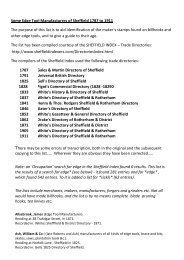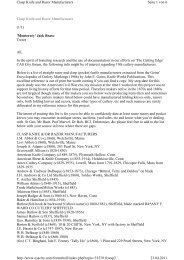razors, razor hones, razor strops and razor honing - antike ...
razors, razor hones, razor strops and razor honing - antike ...
razors, razor hones, razor strops and razor honing - antike ...
Create successful ePaper yourself
Turn your PDF publications into a flip-book with our unique Google optimized e-Paper software.
i7<br />
tlie full length of the hone (from A to B), turning the <strong>razor</strong>, then back the full<br />
length of the hone (from B to A) nd so on, holding the edge to the front as indicated<br />
by the arrow points, counting the strokes as you proceed until you have<br />
nearly reached the number specified with the description of the kind of hone you<br />
are using. Then wet your finger nail <strong>and</strong> draw the edge lightly across the nail.<br />
If it adheres to the nail smoothly <strong>and</strong> evenly take a half dozen short, light strokes,<br />
making the letter X with thin lather, (if you are using lather, but if you are using<br />
oil, add a few drops more <strong>and</strong> if you are using water hone, add water to finish).<br />
Then wet the end of your finger on your tongue until sensitive <strong>and</strong> draw over the<br />
edge, noticing whether it adheres evenly, smoothly <strong>and</strong> keenly. If not, draw a few<br />
more very short strokes <strong>and</strong> try again in the same manner. Care should betaken to<br />
avoid over <strong>honing</strong>. It is better to stop before it is quite done, than to over hone.<br />
Barbers who are unable to feel the keenness of the fine edge, will have better success<br />
by using water <strong>hones</strong>, but to them I would recommend the Eclipse, the Star,<br />
the Finest Grit <strong>and</strong> the Japanese <strong>hones</strong>.<br />
Fifth. When <strong>honing</strong> a very dull <strong>razor</strong> begin by rubbing four or five strokes, to<br />
<strong>and</strong> fro, the full length of the blade, from C to D, without turning the <strong>razor</strong>, (see cut<br />
No. 2), resting the thumb <strong>and</strong> fingers of the left h<strong>and</strong> on the end of the blade to<br />
steady the motions <strong>and</strong> hold the <strong>razor</strong> even <strong>and</strong> flat on the hone, bearing on according<br />
to thickness of the <strong>razor</strong>.<br />
(Thin <strong><strong>razor</strong>s</strong> will not st<strong>and</strong> much weight or bearing on, as they are apt to spring






